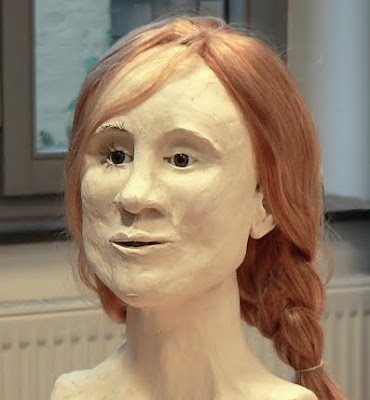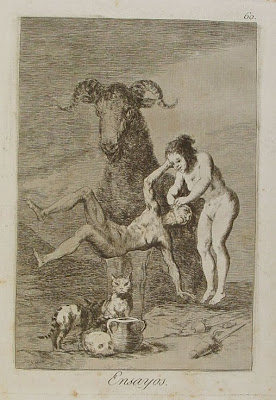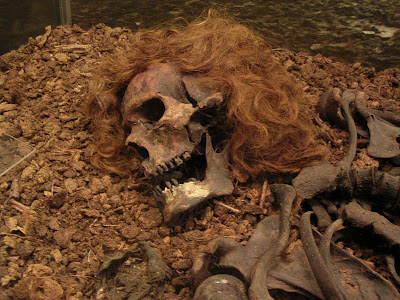Bog bodies or bog people are the naturally preserved corpses of humans and some animals recovered from peat bogs. The bodies have been most commonly found in the Northern European countries of Denmark, Germany, The Netherlands, United Kingdom and Ireland. Unlike most ancient human remains, bog bodies have retained their skin and internal organs due to the unusual conditions of the surrounding area. These conditions include highly acidic water, low temperature, and a lack of oxygen, combining to preserve but severely tan their skin. Despite the fact that their skin is preserved, their bones are generally not, as the acid in the peat dissolves the calcium phosphate of bone. Most, although not all, of these bodies have been dated to the Iron Age. Many show signs of having been killed and deposited in a similar manner, indicating some sort of ritual element, which many archaeologists believe show that these were the victims of human sacrifice in Iron Age Germanic paganism; though Cornelius Tacitus specifically describes bogging as a form of (sacralized) capital punishment in his 1st century work Germania.Hundreds of bog bodies have been recovered and studied. For a list of much more bog bodies visit
wikipedia
The
Tollund Man is the naturally mummified corpse of a man who lived during the 4th century BC, during the period characterised in Scandinavia as the Pre-Roman Iron Age. He was found in 1950 buried in a peat bog on the Jutland Peninsula in Denmark, which preserved his body. The head and face were so well-preserved that he was mistaken at the time of discovery for a recent murder victim.The Tollund Man has been noted for the excellent preservation of his facial features. With the body, a sheepskin cap and a belt were found, although no additional article of clothing was preserved, likely to have decomposed. He also had a noose around his neck, indicating that he was hanged. Only his head remains original in his museum display due to lack of preservation knowledge at the time of discovery. It is believed that the Tollund Man was a ritual sacrifice victim.
The
Bocksten Bog Man is the remains of a medieval male body found in a bog in Varberg Municipality, Sweden. It is one of the best-preserved finds in Europe from that era and is exhibited at the Varberg County Museum. The man had been killed and knocked to the bottom of a lake which later became a bog. The bog where the body was found lies about 15 miles east of Varberg on the west coast of Sweden, close to the most important medieval road in the area: the Via Regia.
The
Osterby Man was discovered in a bog near Osterby, Germany, when two peat cutters were working. They unearthed the head two feet below the surface, which was wrapped in a roedeer skin cape. Scientists from the Archäologisches Landesmuseum Schleswig-Holstein estimated the man to have been around 50–60 years of age when he was killed. The man was decapitated; no other part of his body was ever found. His hair was in the Suebian knot hairstyle. The man’s hair had probably been a light blond color, but after being in the bog for a few thousand years, it turned a bright red. The knot dates back to around 2,000 years ago, where the Suebian knot was a common hair style. The Roman historian Tacitus described this style as typical of the Suebi tribe. The head is mainly a skull, but there is still a small amount of skin on it. The cause of the man’s death was a blow to the left temple.
The
Grauballe Man is a bog body that was uncovered in 1952 from a peat bog near to the village of Grauballe in Jutland, Denmark. The body is that of an adult male dating from the late 3rd century BC, during the early Iron Age. Based on the evidence of his wounds, he was most likely killed by having his throat slit open. His corpse was then deposited in the bog, where his body was naturally preserved for over two millennia. His was not the only bog body to be found in the peat bogs of Jutland, with other notable examples being Tollund Man and the Elling Woman, thereby being a part of an established tradition at the time; it is commonly thought that these killings, including that of Grauballe Man, were examples of human sacrifice, a possibly important rite in Iron Age Germanic paganism. Grauballe Man has been described as “one of the most spectacular discoveries from Denmark’s prehistory” because it is one of the most exceptionally preserved bog bodies ever to be recorded. In 1955 the body went on display at the Moesgaard Museum near Aarhus, where it can still be seen today.

The
Rendswühren Man was discovered in 1871, at the Heidmoor Fen, near Kiel in Germany. He was examined by autopsy, which at the time was the only way of examination. Professor P.V. Glob wrote that Rendswühren Man was estimated to have been 40–50 years of age when he was battered to death, which left a triangular hole in his head. He was found naked, with a piece of leather on his left leg. A cape was found near him. After discovery, his corpse was smoked for preservation. Textile typologically the clothing found with the body has been dated into the Roman Iron Age of the 1st or 2nd century CE.
Huldremose Woman is the name of the bog body of an elderly Iron Age woman discovered in 1879 near Ramten, Jutland, Denmark. The body, found clothed in a wool skirt and two skin capes, dated between 160 BCE and 340 CE. At the time of death, the woman was more than 40 years old—considered elderly for people of that time period. Her right arm was severed, but the injury was determined to have probably occurred by shovels during the unearthing. A wool cord tied her hair and enveloped her neck but forensic analysis found no indication of death by strangulation.
Damendorf Man was discovered in 1900 in the Seemoor at the village Damendorf in Schleswig-Holstein, Germany. The remains are currently on display at the Archäologisches Landesmuseum. Professor P.V. Glob wrote that the man died in 300 BCE.
What is unique about this bog body is the fact that the weight of the peat in the bog had flattened his body. Only his hair, skin, nails, and his few clothes were preserved. He was found with a leather belt, shoes, and a pair of breeches.
In 1946,
Borremose man was discovered by peat diggers in the southernmost part of Borremose. First thought to be a murder victim, the body was later determined to be a bog body. The body was found a half meter down beneath a layer of birch sticks. The body was naked and two sheepskin coats and a woven cap lay beside it. Forensic analysis estimated the man’s height at 1.55 m (5 ft 1 in) and carbon dating placed the age of the body at ca. 700 B.C. Borremose Man was found with a 36 centimetres (14 in) rope with a slipknot around his neck indicating death by strangulation. However, examination also revealed a crushing blow to the back of the skull and the right femur had been broken.
And some reconstructions of what seemed to be the original people have been made, especially for two women:
Yde Girl is a bog body found in the Stijfveen peat bog near the village of Yde, Netherlands. She was found on 12 May 1897 and was reputedly uncannily well-preserved when discovered (especially her hair), but by the time the body was turned over to the authorities a fortnight later it had been severely damaged and deteriorated. Carbon-14 tests have indicated that Yde Girl died between 54 BC and 128 AD at an approximate age of 16 years. She had long reddish blond hair, but one side of her head had been shaved before she died. Scans have shown that she suffered from a spine condition known as scoliosis.
The body was found clad in a woolen cape and with a woolen band, made in a braiding technique known as sprang wrapped around the neck, suggesting she was executed or sacrificed. There was also a stab wound in the area of her collarbone, but that was not determined as the cause of death. As with most bog bodies, the skin and features are still preserved because of the tannic acid in the marsh water. The Yde Girl became internationally known when Neave made a reconstruction of her head, using techniques from plastic surgery and criminal pathology.

The
Girl of the Uchter Moor also known as
Moora is the name given to the female Iron Age bog body remains, discovered in 2000 in the marshland near Uchte, Germany. The remains include vertebrae, hair and skull pieces. The radiocarbon dating performed at the University of Kiel showed that Moora had died between 764 and 515 BCE. Despite common Iron Age burial practices, the body was not cremated. Moora was determined to be between 17 and 19 years old at the time of her death. She had slightly red hair and was left-handed. It is thought that Moora experienced intense physical labour and likely repeatedly carried heavy loads, like water jugs, while roaming through the marshland. According to Saring Dennis from the University Hospital Hamburg-Eppendorf, Moora sustained at least two partial skull fractures that gradually healed themselves. Moora also suffered long periods of sickness associated with the hardships of long winters. The bone growth lines showed that during her childhood and adolescence, Moora suffered from chronic malnutrition. Moora was also diagnosed to have a benign tumor at the base of her skull, which led to the spine curvature and chronic inflammation in the leg bones. However Moora's cause of death is unknown. It was only determined that Moora was naked at the time she was deposited into the bog.




























































.jpg)



